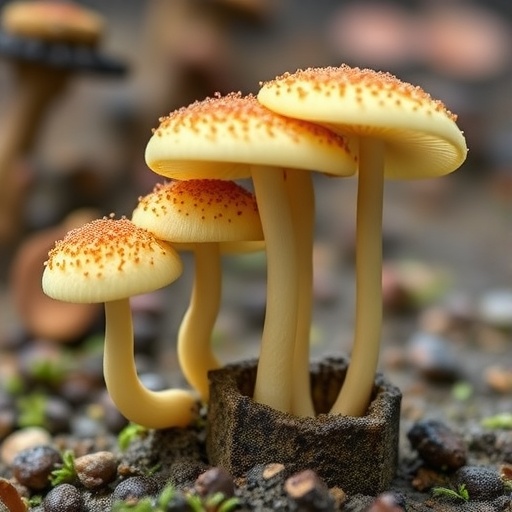In the intricate realm of fungal biology, the production and germination of spores stand as pivotal processes that influence both natural ecosystems and industrial applications. A recent groundbreaking study unveils the profound impact of spore production strategies of the fungus Penicillium camemberti when cultivated in solid media, highlighting variations that significantly affect the spores’ germination capabilities. This discovery not only deepens our understanding of fungal reproductive biology but also holds transformative potential for food biotechnology, particularly in the artisanal and industrial cheese-making industries where P. camemberti plays an indispensable role.
This study delves into the nuanced strategies by which P. camemberti generates spores in a solid culturing medium, contrasting these strategies’ effects on the spores’ ability to initiate germination. The research team employed meticulous culturing techniques on solid media, varying parameters that influence spore formation, such as nutrient availability, growth duration, and hyphal density. Their approach was tailored to discern qualitative and quantitative differences in spore morphology, size, and physiological readiness.
.adsslot_stgTCX7qBe{ width:728px !important; height:90px !important; }
@media (max-width:1199px) { .adsslot_stgTCX7qBe{ width:468px !important; height:60px !important; } }
@media (max-width:767px) { .adsslot_stgTCX7qBe{ width:320px !important; height:50px !important; } }
ADVERTISEMENT
One of the critical technical revelations was that spores originating from densely populated hyphal networks exhibited markedly enhanced germination rates compared to those derived from sparsely colonized conditions. This phenomenon likely stems from the intricacies of intercellular communication and resource allocation within dense mycelial mats, which could prime spores metabolically for rapid germinative responses. Moreover, spore surface characteristics, including hydrophobicity and cell wall thickness, were subtly but significantly altered depending on the production milieu, influencing water uptake and enzymatic activation during germination.
The research also leveraged advanced microscopy coupled with fluorescent staining techniques to track germination events in real time, allowing for precise measurement of germ tube emergence frequency and timing. Such technical innovations provided unprecedented granularity, confirming that the optimized spore production conditions led not only to faster germination onset but also to more synchronized germ tube extension across spore populations.
Intriguingly, this investigation brings to light the multifaceted role of secondary metabolites secreted during spore formation. These bioactive compounds, often overlooked, appear to modulate spore germination by acting either as stimulants or inhibitors depending on their concentration and the environmental context. The solid medium’s composition directly influenced the profile of secreted metabolites, thereby indirectly shaping germination dynamics.
In industrial terms, these findings could revolutionize starter culture preparation for cheese production. By manipulating spore production strategies, cheese producers might harness more robust and predictable mold growth, enhancing rind development quality and consistency. This improvement is particularly pertinent given the rising consumer demand for artisanal cheeses with exquisite texture and flavor profiles, where mold behavior is a cornerstone of differentiation.
The study’s implications extend beyond the dairy sector. Fungal spores are notorious agents in biotechnology and pharmaceutical production, biocontrol frameworks, and even biodeterioration contexts. Understanding how production conditions tailor spore readiness could facilitate enhanced fungal strain development with bespoke germination characteristics, optimizing yields and functional efficiencies in diverse applications.
This research also addresses a long-standing gap in the fundamental mycology of industrial fungi. Historically, studies tended to focus on spores harvested from liquid cultures or unspecified solid substrates, without rigorous attention to how exactly the culture environment shaped subsequent germination. By standardizing and dissecting the spore production process on solid media, the study sets a methodological benchmark for future fungal biology investigations.
At a molecular level, preliminary transcriptomic data hinted at differential gene expression patterns in spores from distinct production regimes, particularly genes associated with cell wall remodeling and stress resistance. These insights open avenues for targeted genetic engineering, aiming to modulate spore germination efficiency by tweaking gene expression during sporulation.
Furthermore, the study underscores the critical importance of adopting integrated analytical frameworks that bridge microbiology, molecular biology, and applied biotechnology. The complex biological phenomena uncovered reflect the multilayered nature of fungal development processes and reinforce the value of multidisciplinary approaches in unravelling them.
Equally compelling is the study’s potential to inspire technological innovations, such as bioengineered solid media tailored for next-generation fungal bioreactors. Such bespoke media could introduce controlled gradients of nutrients and cues, systematically steering spore physiology toward desirable phenotypes.
Altogether, this research by Fourié, Basset, Timoumi, and colleagues constitutes a vital leap forward in decoding the complex life cycle of Penicillium camemberti, emphasizing the critical influence of spore production conditions in solid media on subsequent germination kinetics and efficiency. Its implications resonate across scientific disciplines and industry sectors, laying foundations for improved fungal management practices and novel biotechnological applications.
Looking ahead, ongoing work is expected to delve deeper into molecular regulators underlying the observed phenomena and to extend the framework to comparative studies involving other commercially relevant molds. The potential for cross-fungal insights promises to enrich the broader mycological canon, aligning practical benefits with fundamental biological knowledge.
In conclusion, by shining a spotlight on the often-overlooked phase of spore production and its instrumental role in determining germination success, this landmark study redefines how we perceive and harness fungal life cycles for both traditional food processes and cutting-edge biotechnology.
Subject of Research: The impact of spore production strategy of Penicillium camemberti in solid media on its germination abilities.
Article Title: Impact of the spore production strategy of Penicillium camemberti in a solid medium on its germination abilities.
Article References:
Fourié, J., Basset, M., Timoumi, A. et al. Impact of the spore production strategy of Penicillium camemberti in a solid medium on its germination abilities. Food Sci Biotechnol (2025). https://doi.org/10.1007/s10068-025-01938-4
Image Credits: AI Generated
DOI: https://doi.org/10.1007/s10068-025-01938-4
Tags: artisan cheese production techniquesCamembert and Brie cheese moldscheese-making biotechnologyfungal reproductive biologyfungal spore germination strategiesgermination potency in fungiimpact of fungal biology on food industryindustrial applications of fungiPenicillium camemberti germinationPenicillium camemberti spore productionsolid media cultivation of fungispore viability factors





